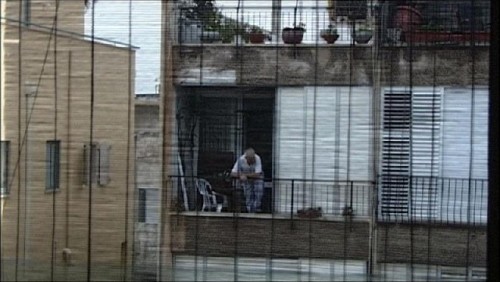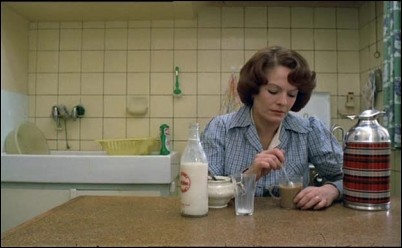Chantal Akerman Moving Thru Time and Space
MIT Curator Bill Arning Gives Insightful Talk
By: Shawn Hill - Jun 28, 2008
Chantal AkermanMoving Through Time and Space
MIT List Visual Arts Center
May 2—July 6, 2008
"Akerman in Her Many Contexts" a talk by LVAC Curator Bill Arning on June 26 in the Bartos Theatre
Bill Arning began his rich and fascinating talk with a frank admission: though Moving Through Time and Space is the cap show for a year of exhibitions exploring the international development of Video Art over the last four decades (we reviewed an earlier show of video art at MIT back in December 2007), and though Chantal Akerman has several "multi-channel" installations on monitors in the galleries upstairs, she is first and foremost a filmmaker, not a video artist.
In fact, the video art installations made by the Belgian artist exist for at least one very practical reason: their commissions provide another funding source for her movies. And they are ultimately aspects of her movies, contingent art works that are based on her films that she has edited into shorter, viewable segments to display on bulky old-fashioned TV monitors on pedestals.
Arning prepared a PowerPoint presentation of imagery to support his informal but comprehensive talk, and he kept it simple: no flashy graphics, just an abundance of big, gorgeous movie stills. Even better, the technical staff at the List was able to seamlessly insert several short film clips at Arning's prompting, giving us brief glimpses into a movie career that has encompassed forty years of innovative, pioneering work.
Akerman is among the first rank of feminist film-makers, a status she began to earn precociously with her first movie at age 16. "Saute Ma Ville" (1968, roughly translated as "blow up my city") shows a young woman (Akerman herself) at home in a domestic environment. As she cooks, cleans, feeds her cat, etc., she grows more and more isolated and manic. Her movements become frantic, and her behaviour erratic: why is she taping up the doors, sealing them shut and sealing herself in?
In her first film Akerman finds the themes that will continue to fascinate her. In the feminist classic "Jeanne Dielman, 23 Quai de Commerce, 1080 Bruxelles" (1975), the iconic French actress Delphine Seyrig occupies a conscripted world as a mother and homemaker and caretaker. The camera movements are slow, often completely stable, the environment again a claustrophobic one of domestic interiors. The film, over three hours long, places so much emphasis on Seyrig's deliberate movements, and her ritualistic domestic behaviour, that even the leaving of a lid off a jar takes on a startling significance.
Jeanne Dielman keeps her world going, as a widow, through the efficacy of prostitution, turning one trick per day. This commercial negotiation in the pursuit of domestic stability is one shown in other French language movies of the era (one thinks of Bunuel's "Belle du Jour" 1967), but never with the focus so much on the domestic sphere rather than the sex. Arning reports that Akerman was struck at an early age how, in commercial films, whenever female characters begin domestic work like cooking or cleaning, in support of the male protagonists of the films, the camera cuts away, completely uninterested. The male gaze remained confident that the story was elsewhere.
Akerman's job, as an artist, was to explore that hidden story, one of female space and action. This goal put her in synch with the aims of the seventies feminist movement, which was struggling not just for equality, but for attention and understanding in a world of double standards and indifference.
There were formal as well as political reasons for the alternative demands on audience attention made by Akerman's movies, which are famous for their extended, static long shots. Akerman moved to New York city in the seventies, and became involved with Structural Cinema, a circle of pioneer avant-garde American film-makers which included Jonas Mekas. "Structural cinema," explains Arning," is the equivalent of Minimalist Art on film." One goal at the time was to achieve ever-longer, ever-slower tracking shots.
More recent works by Akerman have taken on an almost documentary tone, though she rejects the documentary label. Though she has explored the Mexican/American border and illegal immigration (in "De l'autre côté" 2002 – "From the other side"); the Israel/Palestine conflict ("Là Bas" 2005 – "Down There") and the American South ("Sud" 1999 – "South"), she stresses that her films remain fictions. She says they're always still about her, as alluded to in the title of her movie and installation exploring post-Communist Eastern Europe: "D'est: Au bord de la fiction" (1995 – "From the East: Bordering on Fiction").
In "LÃ Bas," for example, our view on Tel Aviv is a strange one. Akerman creates a subjective response to a city and a political situation, not an objective analysis. The main character, Akerman again, is a foreigner with a temporary commission in Israel, subletting a furnished flat. Most of the film's action takes place in the apartment, a shadowy realm where slatted blinds are constantly drawn. It is through these blinds that the main character views her new environment, looking for life on other balconies in other buildings. When she does eventually venture out (for cigarettes, as she's been making do with food left behind by the apartment's owner) she hears of a fatal bombing from the tobacconist. This news makes her seem even more isolated and threatened, though ultimately she realizes she has a built-in escape plan: as a foreign visitor, she has a life to return to elsewhere. Her stay will be a temporary one. The film questions the ultimate effect of any one individual on such a complex and war-scarred situation; will her visit even leave a trace?



